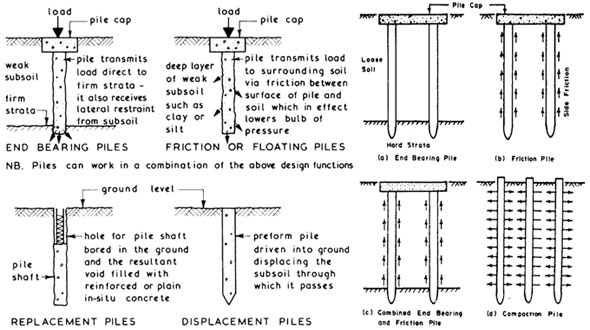Types of piles generally found in construction
- Concrete Cost Estimator
- Concrete Continuous Footing
- Landscape Bidding and Estimating
- Construction Cost Estimating
- Concrete and steel cost estimation
- Construction Cost Estimate Breakdown
- Construction Estimating Worksheet
- Home Construction Cost Estimate
- Estimate Pricing Sheet
- Sheet for General Contractor
- Construction Cost Estimate
- Labor Materials Cost Estimator
- Masonry Estimating Sheet
- Sheet for Building Contractor
- Construction Schedule Bar chart
- General Cost Estimator Sheet
- General Construction Estimate
- Building and Road Estimating Sheet
- Detailed expense estimates
- Door and Window Takeoff Sheet
- General Construction Cost Estimating Sheet

On the basis of load transfer and functional behavior, the piles are categorized as follow :-
1. End bearing piles (point bearing piles) 2. Friction piles (cohesion piles) 3. Combination of friction and cohesion piles
End bearing piles: These piles deliver their load on to a rigid stratum that is situated at a substantial depth under the base of the structure and they obtain most of their carrying strength from the penetration resistance of the soil at the foot of the pile.
The pile functions as an ordinary column and should be designed in its current manner. Even in substandard soil a pile will not collapse by buckling and this effect is taken into consideration when section of the pile is unsupported, that means if it is in either air or water.
Load is delivered to the soil through friction or cohesion. But occasionally, the soil that encircles the pile may comply with the surface of the pile and produces “Negative Skin Friction” on the pile. It, often influence the strength of the pile significantly. Negative skin friction occurs with the seepage of the ground water and compression of the soil.
Friction Piles: Under these types of piles, the load on pile is primarily countered by skin/friction resistance along the side of the pile (pile shaft). The friction piles are very effective for the soils with no cohesion like sands of medium to low density, since they can enhance the density as well as the shear strength.
If there is no layer of rock or rocklike material at a sensible depth at a site, point/end bearing piles become very long and too expensive. The piles are arranged through the softer material to fixed depth toward this type of subsoil condition.
Timber piles: Timber piles are formed with tree trunks pushed with small end as a point
Maximums length: 35m; optimum length: 9 – 20m
Max load for usual conditions: 450kN; optimum load range = 80 – 240kN
Benefits: Preliminary set up cost is significantly low, permanently submerged piles have strong resistance capacity against decay, easy to use, mostly effective for friction piles in granular material.
To get more information on other types of piles, go through the following link civilsnapshot.com

- Application of concrete calculator
- Roofing Calculator can streamline the roof estimating process
- House construction cost calculator
- Engineering column design excel spreadsheet
- Material Estimating Sheet with Excel
- Materials List and Cost Estimate Worksheet
- Concrete Slab Estimating Calculator Sheet
- Common types of foundations for buildings
- Online calculation of construction materials
- Estimating with Excel for the Small Contractor
- Concrete Beam Design Spreadsheet
- Virtual Construction Management app for construction
- Autodesk’s Project Skyscraper
- Reed Construction’s Reed Insight
- Manage your construction project documentation
- Costimator, the popular cost estimating software
- On Center Software for construction professionals
- Free Construction Estimating Software
- Plumbing Calc Pro
- Cost Estimate Worksheet
- HVAC Piping Quantity Takeoff Worksheet
- Construction Estimating Software Sheet
- Estimate Cost Templates
- Construction Punch List
- Construction cost estimating template consisting estimating basic
- Gantt Chart Template for Excel
- Download Civil Engineering Spreadsheets with Verification
- The Building Advisor Estimating and Budgeting Worksheet
- Spreadsheet for design of concrete bridge
- Construction Estimating Software Free








